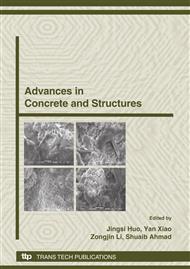p.69
p.81
p.89
p.101
p.107
p.115
p.121
p.125
p.131
Energy-Controlled Design of Reinforced Ultra-High Performance Fiber Concrete Slabs against Airblast Loads
Abstract:
Displacement-controlled design method is now being used by current guidelines such as TM5 and ASCE to design RC members against airblast load. If the maximum deflection of the designed member under airblast loads is less than the allowable deflection, the designed member is considered to be safe. Although the displacement-controlled design method is easy to use, it may not result in a design having maximum energy-absorption capacity against airblast loads, especially for a design of a reinforced ultra-high performance fibre concrete (RUHPFC) member which is of both high strength and high ductility, that is, high energy-absorption capacity. In this paper, a layered analysis model allowing for varying strain rates with time as well as along the depth of the member was used to calculate energy-absorption of a simple supported RUHPFC slab under airblast loads. An optimal reinforcement ratio of the slab was achieved by maximizing the energy absorption of the slab under different reinforcement ratios. The energy-controlled design method was validated by field blast tests. Using the validated design method, a designed slab with the optimal reinforcement ratio was also tested and the effectiveness of the design was demonstrated.
Info:
Periodical:
Pages:
107-112
Citation:
Online since:
October 2008
Authors:
Price:
Сopyright:
© 2009 Trans Tech Publications Ltd. All Rights Reserved
Share:
Citation:


